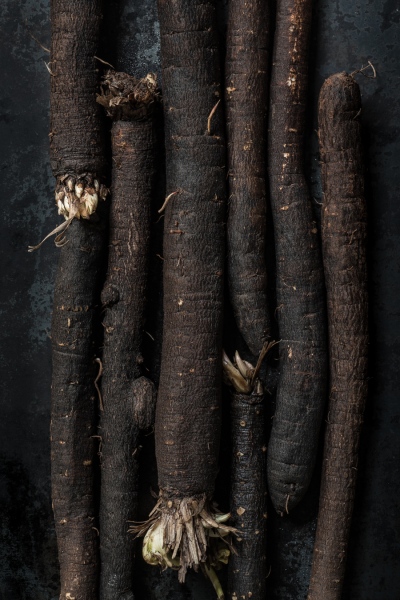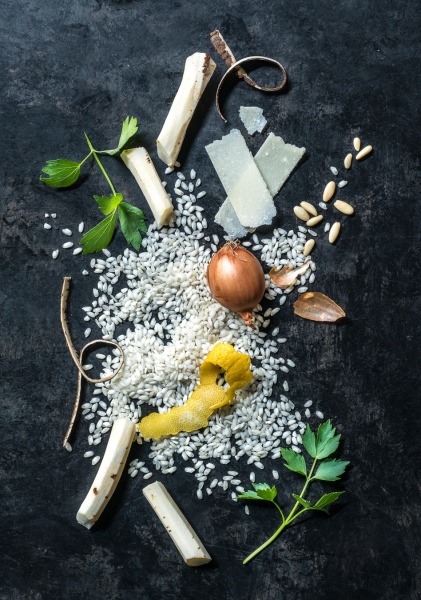The salsify is often mockingly referred to as “winter asparagus” or “asparagus for poor people.” We find that completely wrong. In our risotto, salsify is the star, not to mention its beneficial effects on health.

Salsify Risotto
Zutaten
SALSIFY RISOTTO
- 500 g salsify
- 300 g risotto Arborio or Carnaroli
- 1 onion finely diced
- 1 organic lemon
- 200 ml dry white wine
- 600 ml hot vegetable stock
- 50 g freshly grated Parmesan
- 2 tbsp butter
- Parmesan shavings
- 1/2 bunch parsley finely chopped
- 3 tbsp roasted pine nuts
- 4 tbsp corn oil
- 2 tbsp olive oil
- Salt and white pepper
Zubereitung
- Wash lemon. Peel off some lemon peel. Squeeze out the lemon and put the juice in a bowl of cold water. Peel salsify under cold water with peeler, while wearing silicone gloves. The peeled salsifycut into 3 to 4 cm long pieces. Give the pieces immediately in the bowl with the lemon water.
- The finely diced onion and 2/3 of the drained salsify sauté in rapeseed oil over medium heat, add the rice and sauté, deglaze with the white wine. Reduce the white wine with constant stirring, add the lemon zest. Stir in hot broth in several steps. After about 18 to 20 minutes total cooking time the rice should be soft, but still al dente. Remove the pot from the stove, stir in the parmesan and butter and season with salt and white pepper.
- For the garnish: Fry the remaining salsify pieces nicely brown in olive oil, season with salt and pepper. Serve the risotto on preheated dishes with the salsify pieces, the roasted pine nuts, Parmesan chips and parsley.
Until the 16th century, the salsify was known only in Spain, where it was known as a wildly growing, effective medicinal plant, for example, against snake bites. Only since then 17th century, salsify were also grown as vegetables. Today they come mainly from Belgium, France and the Netherlands. The salsify is a typical winter vegetable, which can be found from October to April, especially on the weekly market, but also in supermarkets and vegetable shops.
Despite its second name “winter asparagus,” the salsify is only remotely reminiscent of asparagus: Its aroma is more intense, rather spicy and slightly nut-like; The consistency is most similar to that of carrots or parsnips.
The salsify contains, according to the pea and the bean, the most nutrients of all vegetables. Calcium and phosphorus are particularly well represented. Thanks to their high content of potassium, black roots also have a naturally draining effect. Most notable, however, is the content of inulin in the salsify. This soluble fiber is considered the purest balm for fat metabolism and intestinal flora. At the same time, however, the inulin is also responsible for the fact that sensitive people can experience digestive problems (bloating, diarrhea) when eating salsify.
Warning: The milk juice that leaps out during cutting is a good sign of optimal freshness, but also discolours the hands. Best put on gloves for peeling and cleaning the salsify. Before peeling the salsify with a vegetable peeler, a thorough cleaning is commonplace: simply clean the vegetables with a brush under running water until the adhering soil is removed. After peeling, place the salsify immediately in a bowl of water and vinegar or lemon juice so they don’t turn dark!



